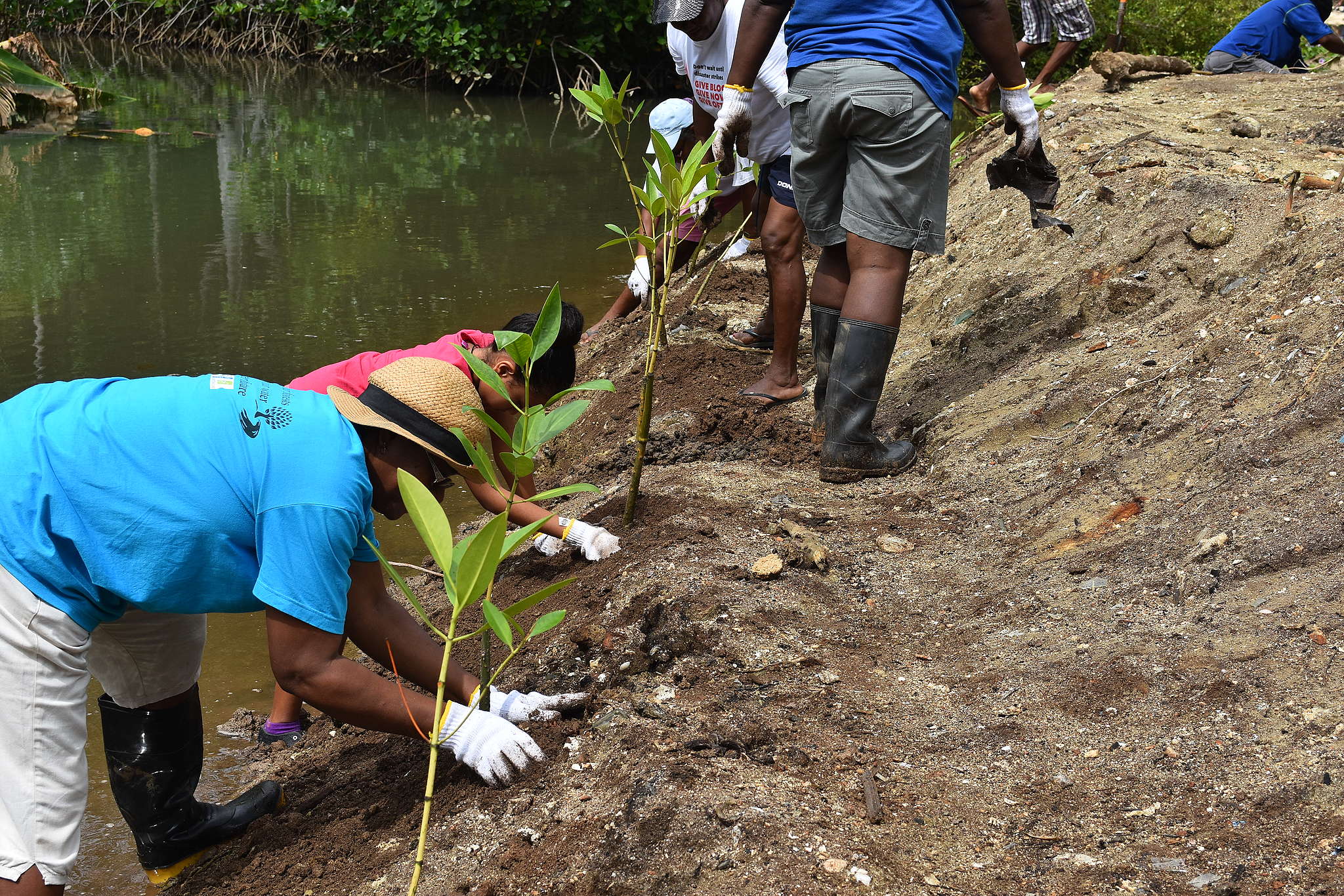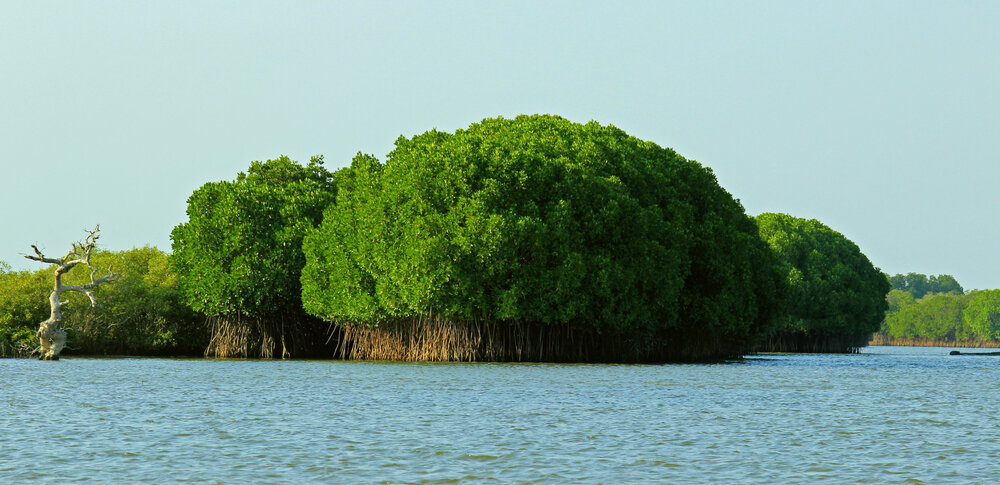FEATURED STORY Loss of mangroves dims the light on firefly populations in Malaysia

MALAYSIA – Every evening, along the banks of the Rembau River in Malaysia, fireflies put on a spectacular display. Against the dark silhouette of the berembang mangroves (Sonneratia caseolaris) they dance, synchronizing their flashing in a bioluminescent performance that draws thousands of tourists every year. In the past decade, however, the light show has somewhat dimmed. As early as 2008, studies on firefly populations in Rembau have revealed significant declines. A confluence of factors has converged to put fireflies at risk of local extinction, and chief among them is habitat loss, a new study has found. Researchers, whose work was published this month in Global Ecology and Conservation, used satellite imagery to monitor changes in land use around Rembau’s mangroves. They found that, between 2002 and 2017, overall mangrove areas had decreased by 17.8% — a loss of 93 hectares (230 acres) of key firefly habitat. According to the study, the top two driving factors behind mangrove loss in Rembau were replacement with oil palm plantations and dryland forests, each of which accounted for a third of mangrove areas lost. READ MORE
GLOBAL
Scientists detail restorative mangrove and peatland management strategies

GLOBAL – Ensuring the health and longevity of wetland ecosystems will not only benefit the environment and help forestall the negative effects of climate change, but will also boost overall economic wellbeing at local, national and international levels, said Robert Nasi, director general of the Center for International Forestry Research (CIFOR) and managing director of World Agroforestry (ICRAF), during a recent webinar.Aquaculture and other shoreline activities — including urban encroachment — in combination with projected sea level rise caused by global warming, puts the very survival of mangroves at risk, said Daniel Murdiyarso, a principal scientist at CIFOR-ICRAF. “Worldwide, mangroves have been severely degraded and reduced to half of their original amount over the past 50 years,” he said during the event, which attracted more than 275 attendees. READ MORE
A functional analysis reveals extremely low redundancy in global mangrove invertebrate fauna

GLOBAL – Global mangrove deforestation and degradation drive the loss of the associated invertebrate fauna vital to ecosystem services. The functional diversity and resilience of this fauna has not been assessed. We show that even small mangrove patches host functionally diverse faunal assemblages and can act as biodiversity reservoirs. However, globally, functional redundancy of mangrove invertebrates (i.e., the average number of species performing a similar functional role in an assemblage) is extremely low, except in Southeast Asia. Thus, even a modest local loss of invertebrate diversity will have significant negative consequences for mangrove functionality and resilience. Current approaches to assess threats to mangroves heavily rely on loss in areal extent, but our results suggest that loss of function may be more vulnerable. READ MORE
AFRICA
Tanzania’s mangrove wetland at risk

TANZANIA – Mangrove forests around the world face existential threats from human activity and climate change. Tanzania’s Rufiji delta, a once thriving natural mangrove wetland, has not been spared. The mangrove wetland has steadily been hived off for rice farming, illegally logged for fuel and timber, and destroyed by upstream activities such as salt production, human settlement, and cattle grazing. Forestry experts also point to an “invasive” lianas plant species that affects mangrove growth. To mark this year’s World International Wetlands day on July 26, Wetlands International, a non-profit body launched a programme to restore at least 2,000 hectares of mangroves at the Rufiji delta, in line with the government’s pledge to restore 5.2 million hectares of forests across the country over the next decade. READ MORE
Ocean health at heart: how communities in Seychelles are driving mangrove rehabilitation

SEYCHELLES – Seychelles is an archipelago of 115 islands located on the east coast of Africa in the Western Indian Ocean. Highly dependent on tourism and fishing as pillars of their economy, Seychelles is a champion of environmental conservation. Wetlands provide many ecosystem services both to the species that rely on them and to the people of Seychelles. They act as filters for pollution and harmful run-off from rainwater – slowing it down and decreasing its erosive ability. Terence Vel and Monica Samson, two of the people very committed to restoring these vital habitats, shared the secrets to their motivation and success with us. “Seychelles’ mangrove forests have seen destruction since the arrival of the first French settlers and it’s sad that some people don’t appreciate the value of this important coastal ecosystem. The Anse Royale wetlands were in a dire state before rehabilitation began; there were only three species of mangroves. Since then, and due to efforts to mimic the composition of the previous forests, there are now six species present,” says Vel. READ MORE
Banjul Plants 500 Mangroves, Targeting 5k

GAMBIA – West African Birds Study Association (WABSA) in collaboration with Banjul residents, on Saturday organised a day-long mangroves planting exercise in order to restore mangroves within the Banjul River and create more space as natural breeding ground for marine species. Alfusainey Gano, project manager for City Link Banjul-Ostend project explained that the 3-year project is funded by the European Union(EU) at an amount of 3.1 million Euros and is under Banjul City Council (BCC). He said that the exercise is one of the project components(greening), adding that part of the overall project framework includestargeting five areas ranging from capacity building, Crab Island, waste management, greening of Banjul and health. READ MORE
AMERICAS
Trapped Saltwater Caused Mangrove Death After Hurricane Irma

USA – When Hurricane Irma hit southern Florida in September of 2017, the storm buffeted coastal mangrove forests with winds over 116 mph – strong enough to rip off leaves, break branches, and snap tree trunks in half. Of the mangrove forest damaged by Hurricane Irma, about 83% recovered after the first year. But the rest didn’t, leaving scientists wondering why some trees didn’t bounce back. Using NASA data collected before and after Hurricane Irma, researchers found that storm surge and trapped seawater – not wind – ultimately caused the trees to die. Trees survived in places where salty ocean water brought in by the hurricane was able to drain, they write in a paper published June 28 in Nature Communications. But in areas where the saltwater was trapped in low lying areas without enough drainage, the mangroves couldn’t recover. The findings suggest that improving the flow of water near submerged mangroves or flushing them with freshwater could help restore mangroves after a hurricane. READ MORE
Nature-based Solutions Needed From Panama’s Coastal Mangroves to Canada’s Boreal Forest

PANAMA – That dynamic juxtaposition of water and land that defines coasts also means that they are typically places of high ecological productivity. Birds, like so many other living things, rely on the richness of life along our coasts for survival. Sandpipers and plovers, ducks and geese, herons and egrets, terns and gulls, and songbirds of every kind—come together in special coastal places, sometimes in the millions, to feed during migration and to nest and raise their young. Yet coastal habitats across the world are also some of the most at-risk systems because humans too are attracted to coasts and what they offer. Mangrove forests in the Bay of Panama compose one of the most important sites for migratory shorebirds in the Americas, with over 2.5 million birds utilizing the area annually alongside over 200 resident bird species. READ MORE
Miami’s rare mangrove forests keeping the city afloat

USA – The few mangroves left in Miami, a city at risk of floods due to rising sea levels, are being taken care of for their properties that could save the city from going under water. The trees have become a precious resource that act as barriers against hurricanes and shelters for animals in the endangered keys of Miami. The first weekend of each month, dozens of volunteers come to Virginia Key, an islet in Biscayne Bay, to clean the mangroves of plastic pollutants and objects that get trapped in the entangled vegetation, which acts as a natural sieve. “Mangroves are the most natural systems that exist to filter the waters,” Irela Bagué, responsible for Biscayne Bay, told Efe. Along with other volunteers, Bagué worked for hours knee-deep in water and under the sun to remove 262 pounds of trash from the North Point mangrove on Virginia Key last weekend. Mangroves are not only the habitat of animal species, but also act as a natural barrier against storms and hurricanes as well as absorb carbon dioxide, which is at the root of climate change and rising sea levels. READ MORE
ASIA
Biodiversity dividend

THAILAND – Making biodiversity an integral part of economic and development strategy can bring a return on investment in economic, social and environmental terms. Southeast Asia, home to at least 60% of the world’s tropical peatlands, 42% of all mangroves and 15% of tropical forests, has huge potential to capitalise such investments. Known for its rich biodiversity, Asean could also play a vital role in the global drive for ecosystem restoration and biodiversity conservation, experts say. Asean leaders and multiple stakeholders have committed to scale up their efforts to achieve sustainable development goals and bring about transformative change through innovation. Thailand and Indonesia, for example, have mainstreamed biodiversity, taking it into consideration in their planning for key development sectors, including agriculture, fisheries, energy, manufacturing, infrastructure and tourism. The aim is to identify the factors that drive biodiversity loss and then take action to ensure a more sustainable way forward. READ MORE
This Initiative Has Been Saving Mumbai’s Mangroves for Over 3 Decades; Here’s Why It’s Crucial

INDIA – To a visitor travelling North toward Thane district from South Mumbai, Vikhroli passes for an ecological oasis amid a stretch of the city’s towering skyscrapers. As soon as you enter the eastern suburb, you will be pleasantly greeted by hundreds of acres of the lesser-known mangroves that man the city’s coastline. Home to several endemic species of flora and fauna, the mangroves are dense coastal forests that are not only essential for maintaining the city’s ecological balance but also a source of income for Mumbai’s traditional fishing community — the Kolis. For generations that have grown up witnessing Mumbai’s picturesque marshlands, estuaries and rivers disappear, the mangroves extending from Vikhroli to the west bank of Thane are a symbol of the city that have thrived and have helped to mitigate the severity of climate catastrophes. In the 1940s, Godrej & Boyce acquired land to set up an Industrial Garden Township for its manufacturing operations and the land was blessed with mangroves along its border. The erstwhile Chairman of the Godrej Group, Sohrabji Godrej and his brother, Naoroji Godrej, had a vision to ensure that nature could co-exist with industries. The Soonabai Pirojsha Godrej Foundation was established in 1985 with the aim of conserving the fragile but life sustaining mangrove ecosystem. READ MORE
Mangrove forests: a miracle of nature

IRAN – Mangrove forests with an area of about 10 million hectares in the world are a safe habitat for thousands of waterfowls, shorebirds, and aquatic species of subtropical regions. However, the influx of polluted water from municipal wastewater, industrial waste, and petroleum products, has threatened the survival of these precious ecosystems and has caused them to shrink more and more. Mangrove forests are able to store about 6 to 8 tons of carbon per hectare of soil per year. Protecting beaches from floods and tsunamis, preventing coastal erosion, supporting the nutrient cycle in water, suitable habitat for plants and animals, producing oxygen due to photosynthesis, providing resin and tannin raw materials, a food source for fish and shrimp, the use of the genes of these trees in biotechnology as genetic resources, medicinal properties, beauty, and natural landscape and tourist attraction are some of the benefits of mangrove forests. These trees are even of spiritual value and sacred to local communities in some countries, but the question is how successful we have been in protecting them. The statistics show that not only were we not successful, but we have also tried hard to destroy the unique habitat. READ MORE
EUROPE
No silver bullet’ for solving challenge of land restoration

U.K. – Complementary approaches are key to tackling the myriad challenges researchers face in designing tree-based land restoration initiatives. “It’s a real mixed bag,” said Anja Gassner, a scientist at World Agroforestry (ICRAF). “We must juggle data, policy, technical support, local socioeconomics, tree genetic resources, invasive species, gender and equity, and land-use policies for specific local contexts.” Gassner, who leads the ICRAF project Harnessing the Potential of Trees on Farms for Meeting National and Global Biodiversity Targets and is science advisor to the Global Landscapes Forum, spoke at a recent virtual conference hosted by Britain’s Kew Gardens in London. READ MORE



























